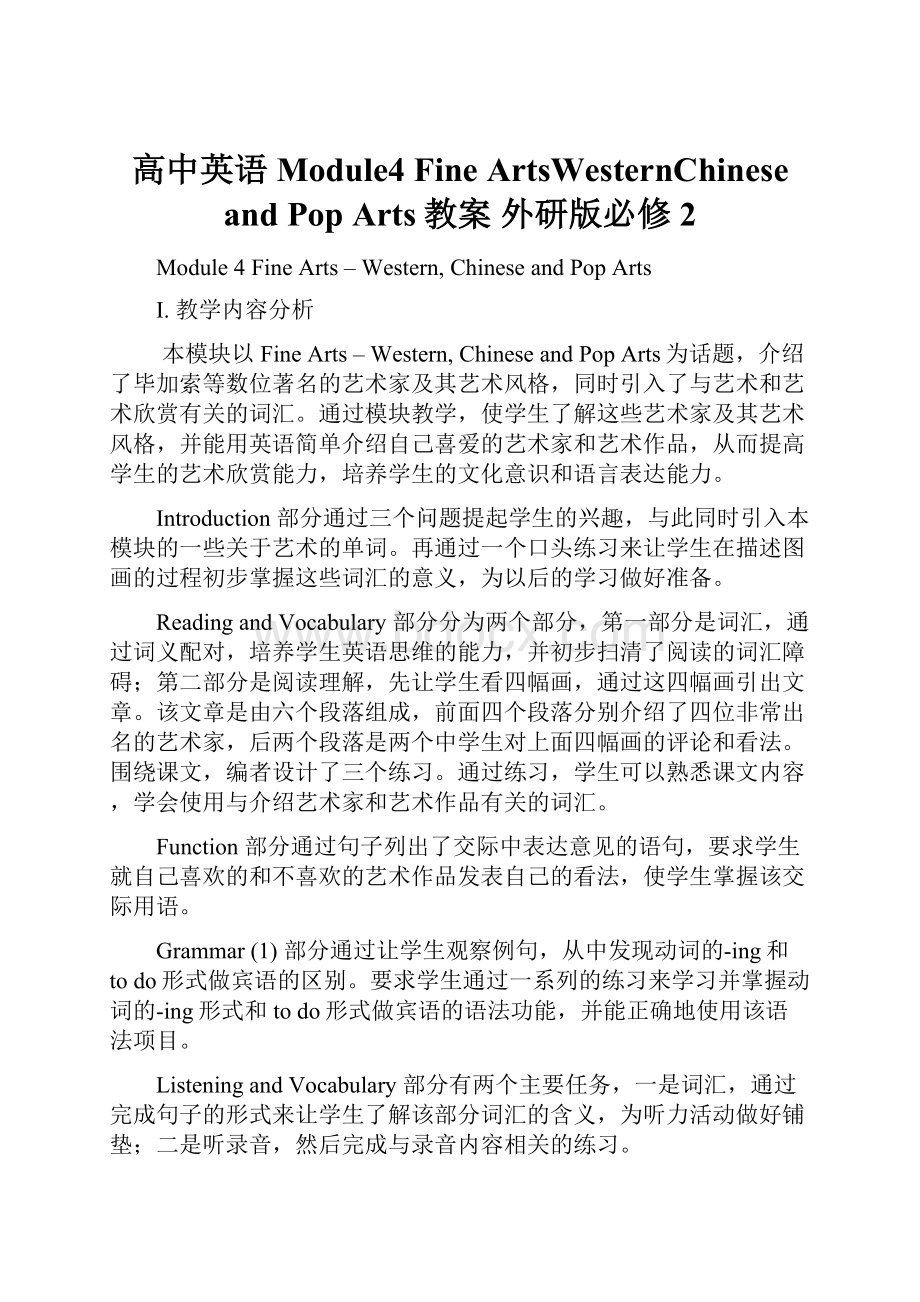高中英语 Module4 Fine ArtsWesternChinese and Pop Arts教案 外研版必修2.docx
《高中英语 Module4 Fine ArtsWesternChinese and Pop Arts教案 外研版必修2.docx》由会员分享,可在线阅读,更多相关《高中英语 Module4 Fine ArtsWesternChinese and Pop Arts教案 外研版必修2.docx(32页珍藏版)》请在冰豆网上搜索。

高中英语Module4FineArtsWesternChineseandPopArts教案外研版必修2
Module4FineArts–Western,ChineseandPopArts
I.教学内容分析
本模块以FineArts–Western,ChineseandPopArts为话题,介绍了毕加索等数位著名的艺术家及其艺术风格,同时引入了与艺术和艺术欣赏有关的词汇。
通过模块教学,使学生了解这些艺术家及其艺术风格,并能用英语简单介绍自己喜爱的艺术家和艺术作品,从而提高学生的艺术欣赏能力,培养学生的文化意识和语言表达能力。
Introduction部分通过三个问题提起学生的兴趣,与此同时引入本模块的一些关于艺术的单词。
再通过一个口头练习来让学生在描述图画的过程初步掌握这些词汇的意义,为以后的学习做好准备。
ReadingandVocabulary部分分为两个部分,第一部分是词汇,通过词义配对,培养学生英语思维的能力,并初步扫清了阅读的词汇障碍;第二部分是阅读理解,先让学生看四幅画,通过这四幅画引出文章。
该文章是由六个段落组成,前面四个段落分别介绍了四位非常出名的艺术家,后两个段落是两个中学生对上面四幅画的评论和看法。
围绕课文,编者设计了三个练习。
通过练习,学生可以熟悉课文内容,学会使用与介绍艺术家和艺术作品有关的词汇。
Function部分通过句子列出了交际中表达意见的语句,要求学生就自己喜欢的和不喜欢的艺术作品发表自己的看法,使学生掌握该交际用语。
Grammar
(1)部分通过让学生观察例句,从中发现动词的-ing和todo形式做宾语的区别。
要求学生通过一系列的练习来学习并掌握动词的-ing形式和todo形式做宾语的语法功能,并能正确地使用该语法项目。
ListeningandVocabulary部分有两个主要任务,一是词汇,通过完成句子的形式来让学生了解该部分词汇的含义,为听力活动做好铺垫;二是听录音,然后完成与录音内容相关的练习。
Grammar
(2)部分通过观察句子,了解动名词形式做主语的现象。
要求学生通过朗读句子,找出相同之处,并根据观察所得学会使用动名词做主语这一语法规则。
Speaking部分要求学生相互问问题,通过一问一答的方式来练习“喜欢与不喜欢”的句型。
该部分内容和前面的Function的内容相一致,建议可放在一起处理。
EverydayEnglishandPronunciation部分列出了几个听力材料里的句子,要求学生理解句子的意思,加深对听力材料的理解。
通过听录音,懂得句中哪些词该弱读,并能正确恰当地使用这些日常用语。
Writing部分先通过阅读ReadingandVocabulary,体会如何寻找并书写主题句。
再通过对一个段落的句子进行重新排序,使学生明确主题句在文章段落中的重要性。
最后要求学生练习写作含有主题句的段落。
CulturalCorner部分是一篇详细介绍毕加索的文章,通过对他三个时期作品的介绍,使学生更加了解这位世界著名的艺术家。
Task部分是对本模块的一个复习与应用,要求学生小组活动,设计一个问卷,调查本班同学对艺术的看法,然后根据调查结果写出调查报告。
ModuleFile部分有助于学生对本模块学习内容进行归纳,对自己的学习进行反思和检验。
II.教学重点和难点
1.教学重点
(1)掌握一些与介绍艺术家、艺术作品有关的词汇。
(2)学习动词-ing形式和todo形式做宾语、主语。
(3)学习表达意见一些日常用语。
2.教学难点
(1)听懂介绍艺术家和艺术作品的有关信息。
(2)确使用动词的-ing形式和todo形式做主语和宾语。
(3)解介绍艺术家和艺术作品的短文和对话,获取有关信息及作者的观点,在阅读中识别新学词汇、短语并推断其意义。
(4)学会写主题句并能介绍自己喜欢或熟悉的艺术家和艺术作品。
III.教学计划
本单元分五个课时:
第一课时:
Introduction,Function,CulturalCorner
第二课时:
ReadingandVocabulary,Speaking
第三课时:
ListeningandVocabulary,EverydayEnglishandPronunciation
第四课时:
Grammar
第五课时:
Writing,Task,ModuleFile
IV.教学步骤:
Period1Introduction,CulturalCorner,Function
TeachingGoals:
1.ToarouseSs’interestinlearningaboutarts;
2.Tointroducethetopic“FineArts–Western,ChineseandPopArts”;
3.TogetSstolearnsomewordstodescribearts;
4.TogetSstoknowsomethingaboutPabloPicasso;
5.ToletSslearnhowtogiveopinions.
TeachingProcedures:
Step1.Introduction
Purpose:
ToarouseSs’interestinlearningaboutarts.
1.Leading-in
ShowsomepicturesonthescreenandasksomequestionsinordertoarouseSs’interestinlearningaboutarts.
(1)Areyouinterestedinart?
(2)DoyouliketraditionalChineseartusingbrushandink?
(3)Canyounametheartistsofthefollowingpictures?
Doyouknowotherfamousartistsathomeandabroad?
SuggestedAnswers:
(1)Variousanswersareacceptable.
(2)Variousanswersareacceptable.
(3)Theartistsofthefourpicturesare:
①DaVinci②DaVinci③XuBeihong④QiBais;Otherfamousartistsare,forexample,Zhangdaqian,PabloPicasso,VincentvanGoghandRoyLichtenstein.
2.PairWork
(1)Introducesomenewwordsbyshowingsomepictures.
artists
artgallery
brushdrawingininks(traditional)Chinesebrushink
painting(contemporary)brushcolorinks
(2)AskSsthefollowingquestion:
Thesetwopaintsbellowareabout①.
SuggestedAnswers:
①
※[比较]scene与scenery
scene指风景,所见之物,包括户内或户外的、城市或乡村的、活动或静态的景物。
scenery指自然景色
Step2.Function
Purpose:
ToenableSstoknowhowtogiveopinions.
1.IndividualWork
AskSstoreadthesentencesinActivity1onP34andunderlinethephrasesgivingopinions.
SuggestedAnswers:
Ithink/Ilike/Ireallylike/Ican’tstand/I’minterestedin/Iwant
2.PairWork
LetSsthinkmoreexpressionsaboutgivingopinions.
Foryourreference:
Ithink/believe…/Inmyopinion,…
Ilike/love/enjoy…
Ireallylike/appreciate…I’mcrazy/madabout…
Ican’tstand…
I’minterestedin…
Iwant/wouldlike/prefer…
…isgreat/wonderful/colourful/delightful/amazing/amusing!
…isawful/dreadful/terrible/ugly!
3.(GroupWork)AskSstolookatthepicturesonthescreen,andtrytousetheexpressionstheyjustlearnttoexpresstheiropinions.Saywhichonetheypreferandwhattheythinkofthepictures.
Step3.CulturalCorner
Purpose:
ToenableSstoknowsomethingaboutPabloPicasso.
1.PairWork
ShowSsapictureandaskthemsomequestionsinordertoarousetheirinterest.
Q1.Whatdoyouthinkofthispicture?
Q2.Doyouknowwhopaintedit?
(PabloPicasso)
2.(IndividualWork)AskSstoreadthepassageanddecidewhetherthestatementstrue(T)orfalse(F).
(1)PicassowasborninGermany.
(2)From1902to1904hepaintedaseriesofpicturesingreen,sothisperiodwasknownasPicasso’sblueperiod.
(3)WithanotherartistcalledGeorgeBraque,hestartedanewimportantartmovementcalledCubism.
(4)Picasso’sgreatestCubistpaintingisaboutacitycalledGuernica.
(5)Picassodidn’tshowhisfeelingsaboutwhathadhappenedinhispictures.
SuggestedAnswers:
(1)F.PicassowasborninSpain.
(2)F.From1902-1904hepaintedaseriesofpicturesinblue,sothisperiodwasknownasPicasso’s“blueperiod”.
(3)T.
(4)T.
(5)F.Picassodidshowhisfeelingsaboutwhathadhappenedinhispictures.
3.(PairWork)AskSstoreadthepassageagainandtrytoretellthelifeofPicasso.
SuggestedAnswers:
(1)Hehadhisfirstexhibitionattheageof16.
(2)Picasso’sblueperiodwasfromthe1902-1904,whenhepaintedaseriesofpictureswherethemaincolorwasblue.Thesepicturesmainlyshowedpoor,unhappypeople.
(3)From1904to1906Picassopaintedmuchhappierpicturesinthecolourpink.ThisperiodwasknownasPicasso’s“pinkperiod”.
(4)WithanotherSpanishartistcalledGeorgeBraque,PicassothenstartedanimportantnewartisticmovementcalledCubism.HisfirstCubistpaintingswereallpaintedinbrownandgrey.ThepictureGuernicaisthegreatestCubistpaintingofhim.
Step4.Homework
1.Reviewthewordswehavelearntinthisperiod.
2.PreviewVocabularyandreadingintheunit.
3.AskSstoprepareapicturetheylikeordislikemost.
Period2ReadingandVocabulary,Speaking
TeachingGoals:
1.ToletSsmasterhowtoreadapassage;
2.ToletSsmastersomewordsandphrases;
3.TogetSstotalksomethingaboutsomeworld-classartistsandtheirstyles;
4.TohelpSstoexpresstheiropinionsabouttheworldfamousartistsandtheirpainting.
Teachingprocedures:
Step1.VocabularyStudy
Purpose:
Tolearnthenewwords.
MatchthesewordsandphraseswiththedefinitionsinActivity1onP32.
(1)style
(2)observe(3)movement(4)imitate(5)alive(6)ordinary(7)aspect
(8)reality
Step2.Reading
Purpose:
ToimproveSs’readingskills.
1.Pre-reading
(1)ShowsomepicturesandletSsexpresstheiropinionsaboutthem.
Whodrewthesepictures?
Whichonedoyouprefer?
Whatdoyouthinkaboutit?
(AllowtheSstotalkwithintwoorthreeminutes.)
(2)ListentothetapeandaskSstotrytoanswerthefollowingquestionsthegeneralinformationaboutthepassage
①Howmanyartistsdoesthepassagemention?
②Whoarethey?
Whataretheirnationalities?
SuggestedAnswers:
①Four.
②
Name
Nationality
PabloPicasso
Spanish
RoyLichtenstein
American
QiBaishi
Chinese
XuBeihong
Chinese
2.While-reading
(1)Readthepassagequicklyandmatchpaintings1—4withdescriptioninparagraphsA—DinActivity2onP32.
SuggestedAnswers:
Picture1:
paragraphCPicture2:
paragraphA
Picture3:
paragraphDPictures4:
paragraphB
(2)Readthefirstfourparagraphsofthearticlecarefullyandfillinthetables.
Name
Nationality
Style
Characteristics
PabloPicasso
Spanish
RoyLichtenstein
American
QiBaishi
Chinese
XuBeihong
Chinese
SuggestedAnswers:
Name
Nationality
Style
Characteristics
PabloPicasso
Spanish
Cubism
differentaspectsoftheobjectorpersonshowingatthesametime
RoyLichtenstein
American
Poparts
showingordinary20thcenturycitylife
QiBaishi
Chinese
traditional
brushdrawinginblackinksandnaturalcolors
XuBeihong
Chinese
traditional
showingrealitylovelyhorses
(3)ReadthepassageagainandchoosethecorrectanswersinActivity3onP34.
SuggestedAnswers:
①A②B③B④A⑤B⑥A
3.Postreading
(1)AskSstoreadparagraphEandFagainandfindouthowtogiveopinionsonsomething.
Foryourreference:
Generalinformation:
I’mstudying…./Idevelopaninterestin….
Likes:
Ienjoy…./I’mcrazyabout…./Iamfondof…./Ilove…./Ireallylike….
Dislikes:
Ican’tstand…./Icangettiredof….
(2)Listentothetapeagainandfillingthemissingwords.
ParagraphA:
Thisisapaintingbythe__①___artist,PabloPicasso,__②__thegreatestwesternartistofthetwentiethcentury.Picassoandanotherpainter,GeorgeBraque,startedCubism,oneofthemostimportantofallmodern___③___.Cubistartistspaintedobjectsandpeople,withdifferent___④__oftheobjectorpersonshowingatthesametime.
ParagraphB:
Thispaintingbycontemporary__⑤__artistRoyLichtenstein(1923-1997)isaworldfamous___⑥__ofpopart.Popart(fromtheword“popular”)wasanimportantmodernartmovementthat__⑦____showordinarytwentieth-centurycitylife.Forexample,itshowsthingssuchas____⑧___cansandadvertisements.
ParagraphC:
QiBaishi(1863—1957),oneofChina’sgreatestpainters,__⑨_____thetraditionalChinesestyleofpainting.Chinesepainting____⑩____itsbrushdrawingsinblackinksandnaturalcolours.Qibaishitheworldofnatureverycarefully,andhispaintingsare
becauseofthis.
ParagraphD:
XuBeihong(1895—1953)wasoneofChina’stwentieth-centuryartists.LikeQiBaishi,Xupaintedint